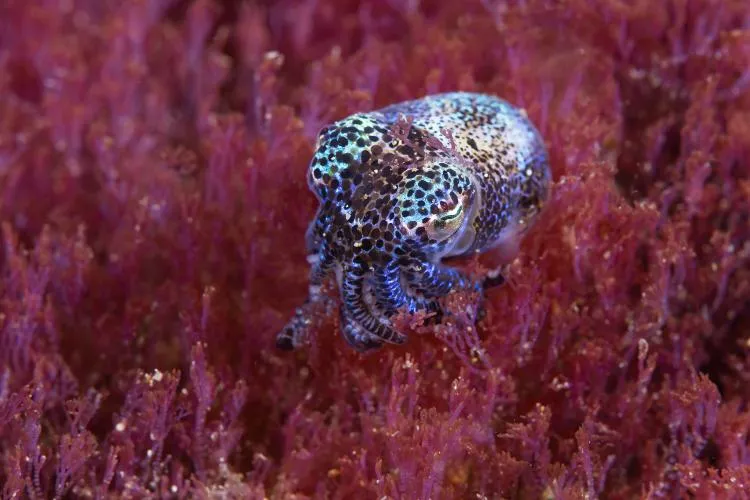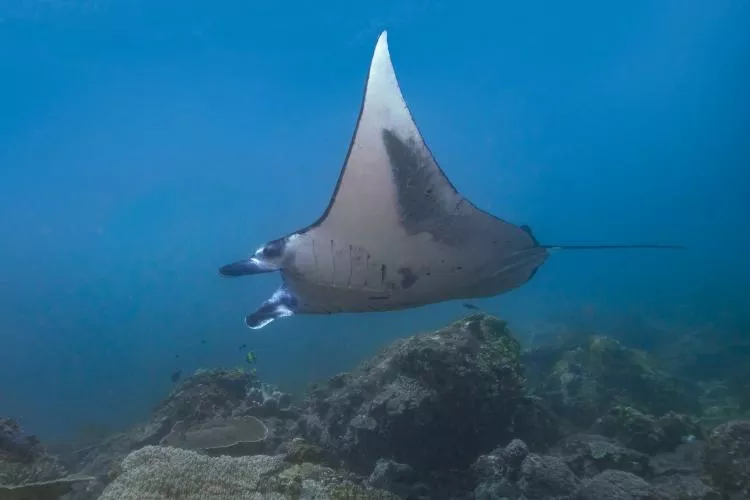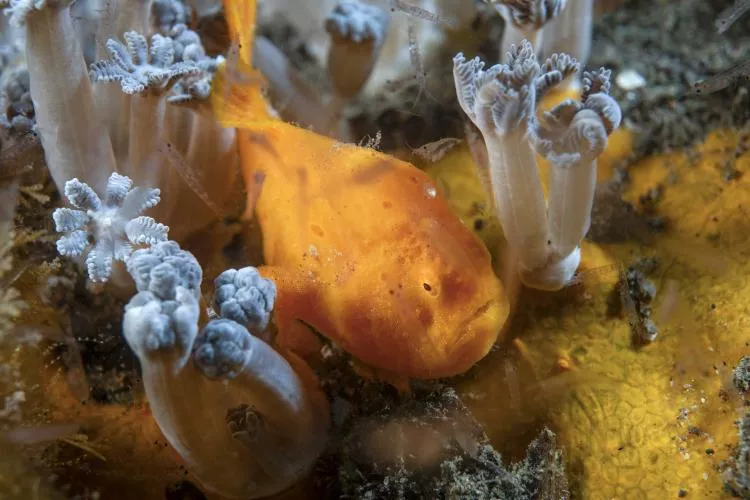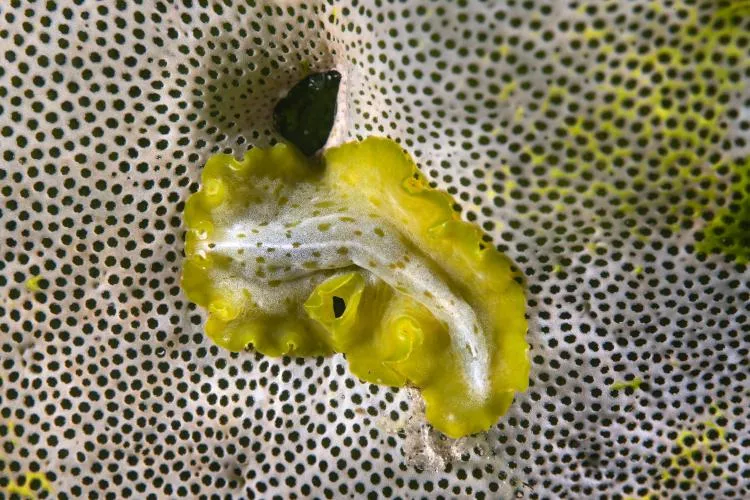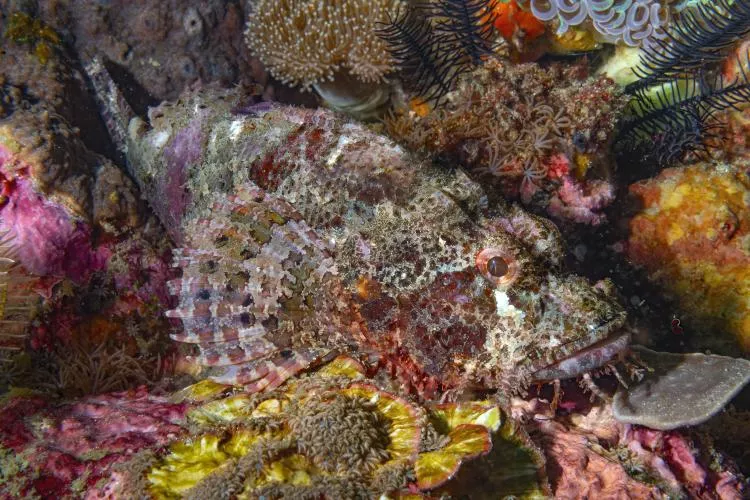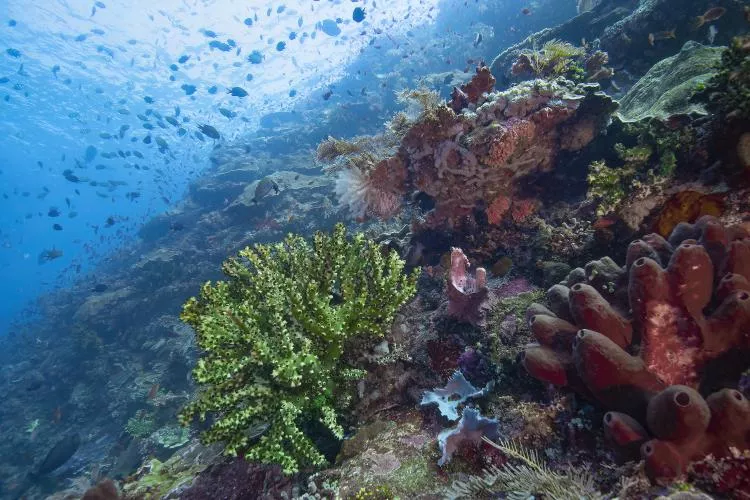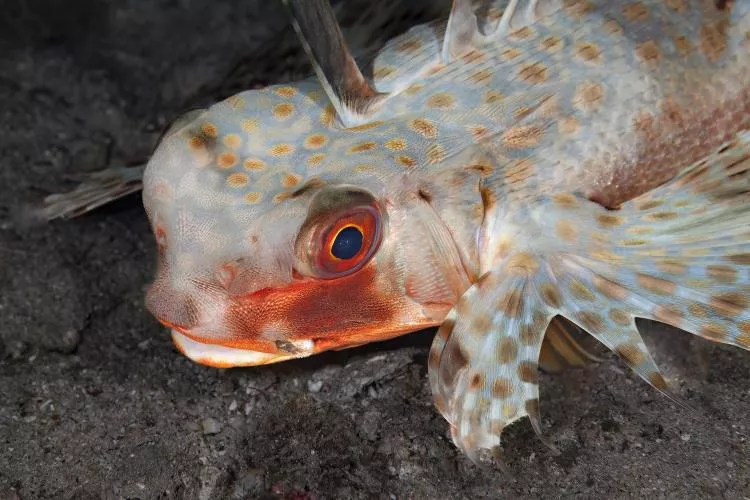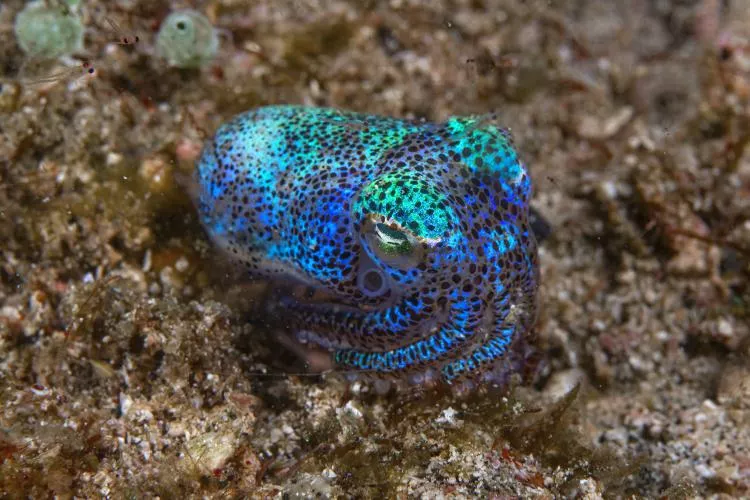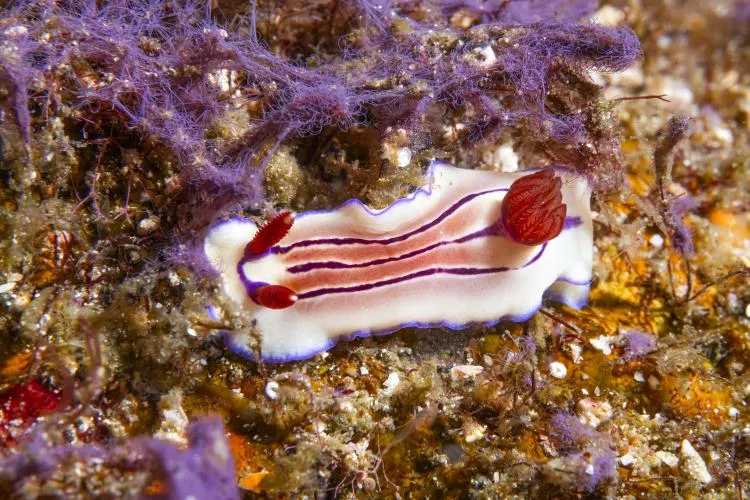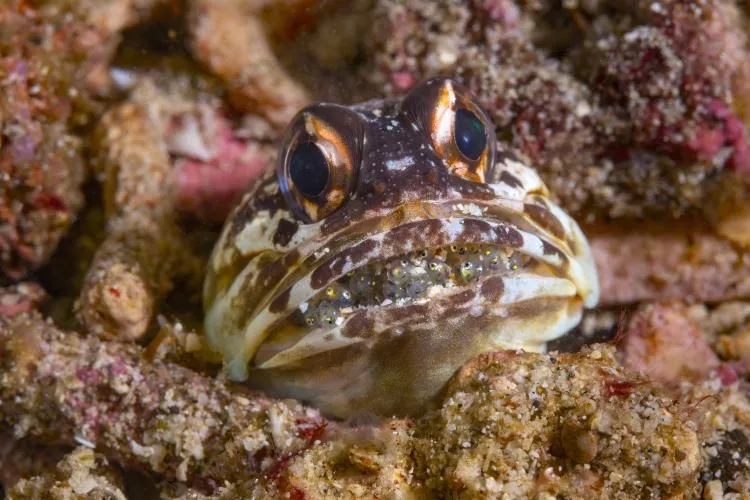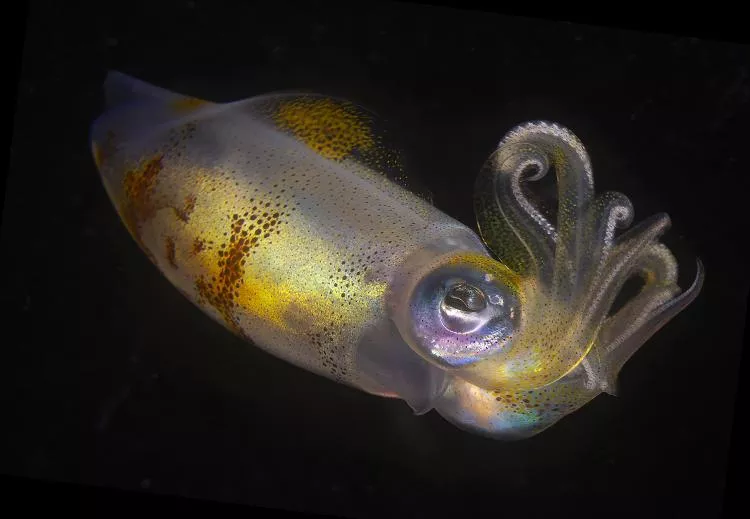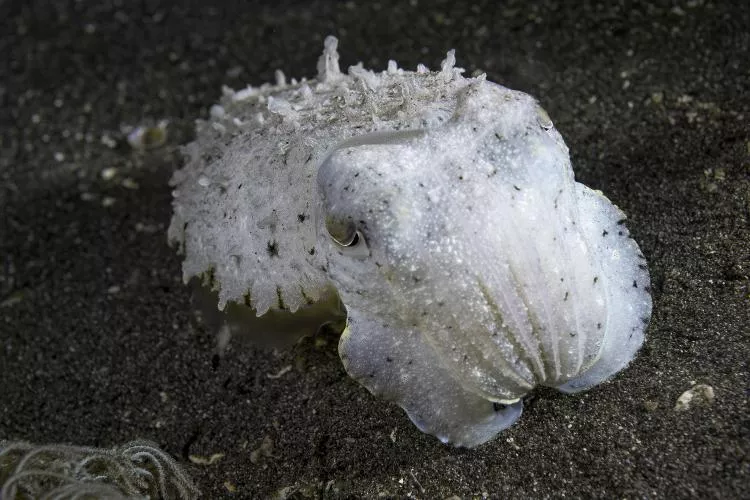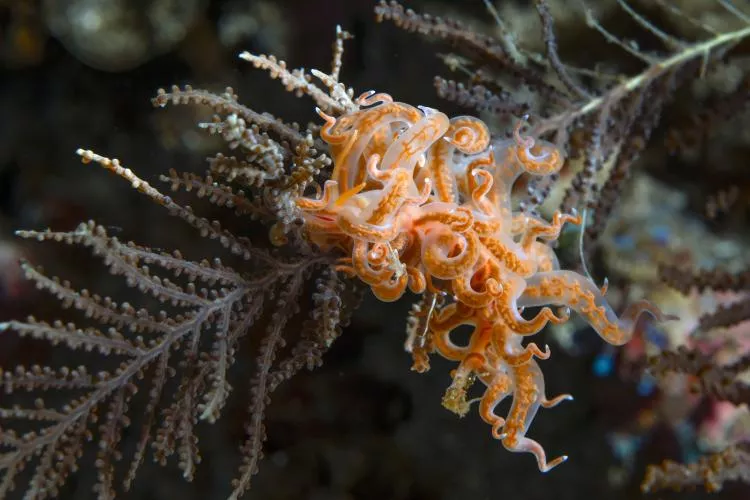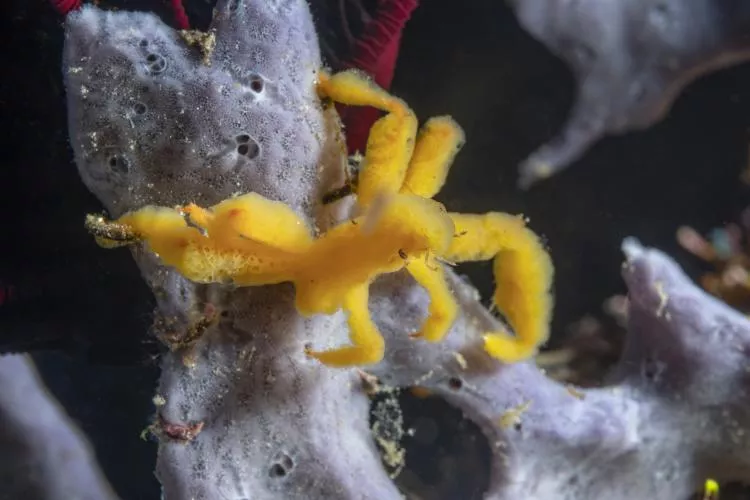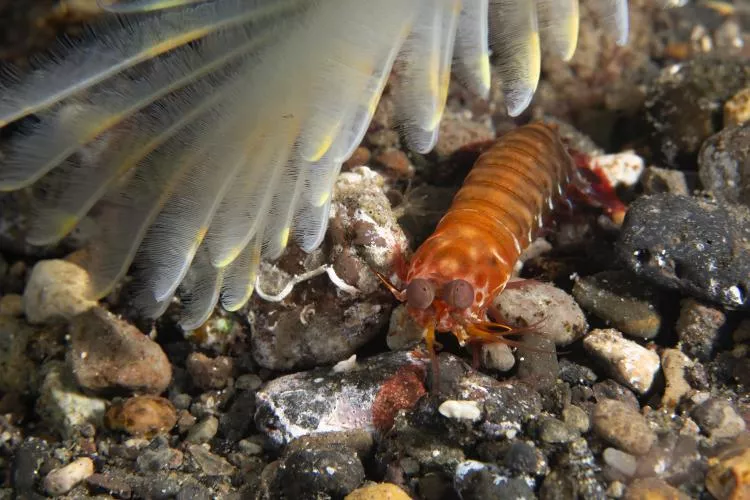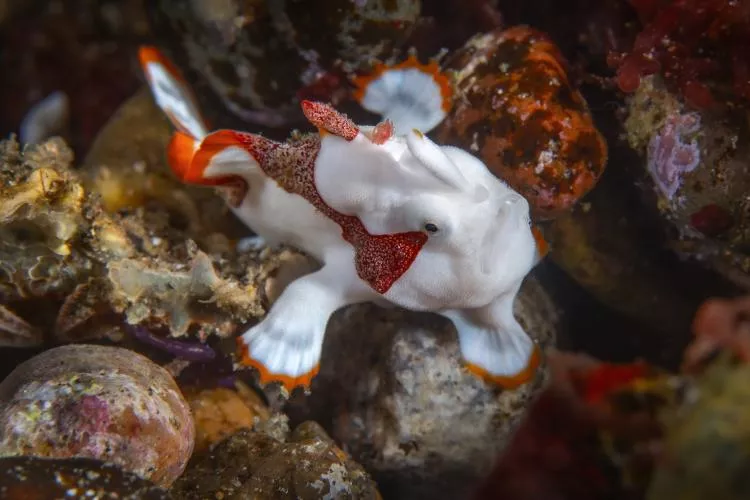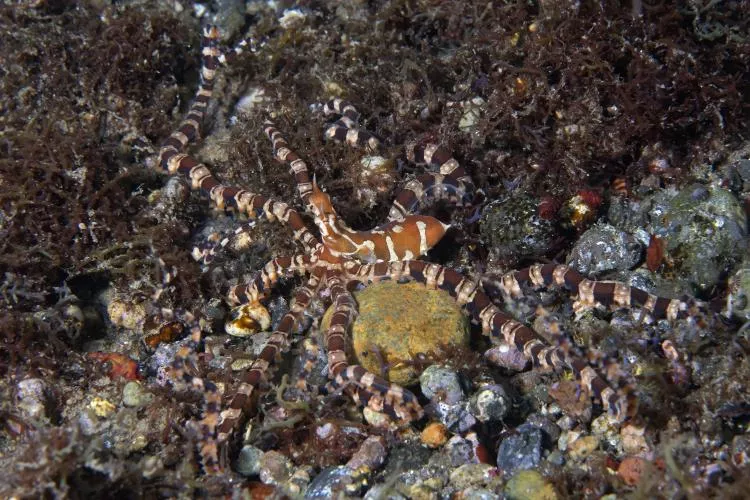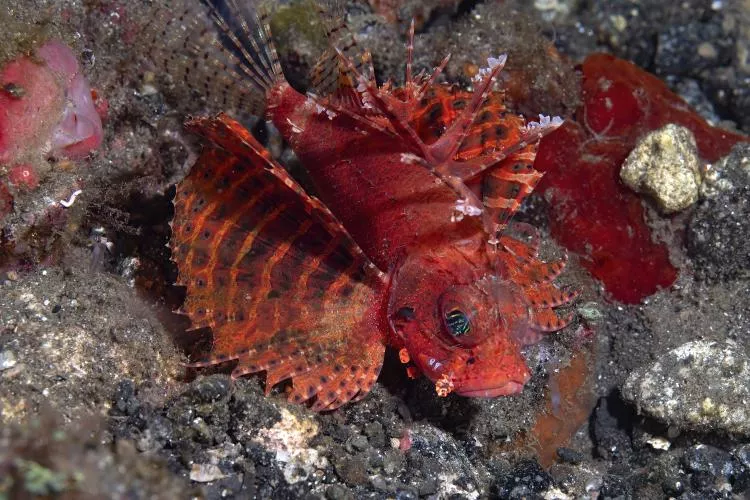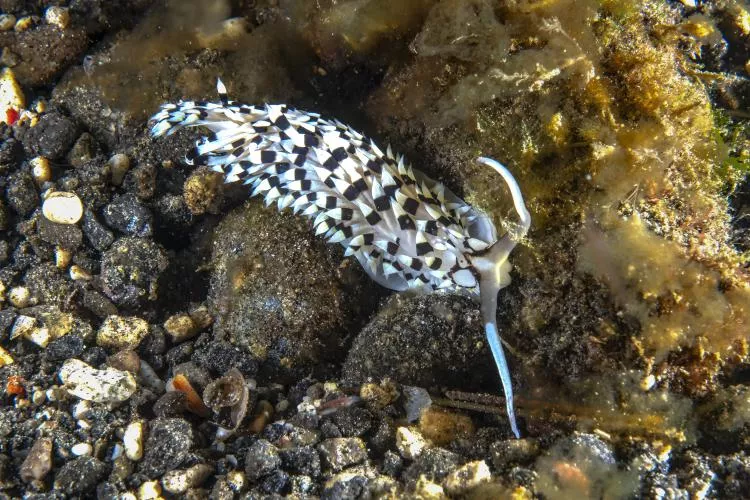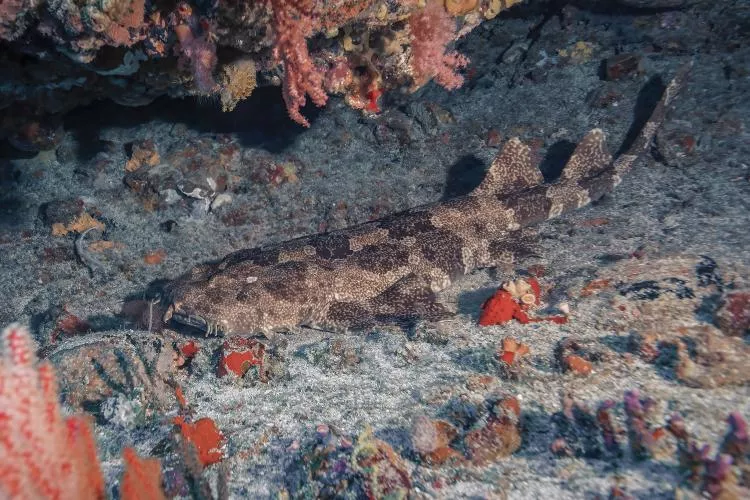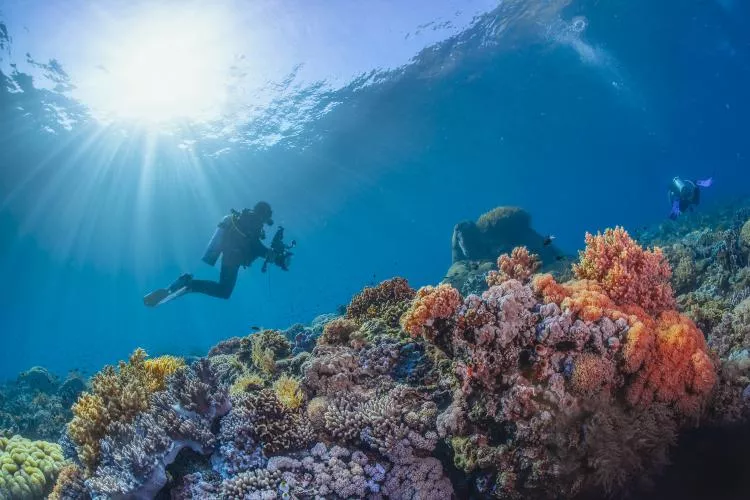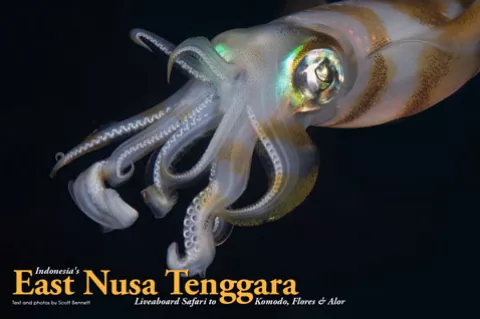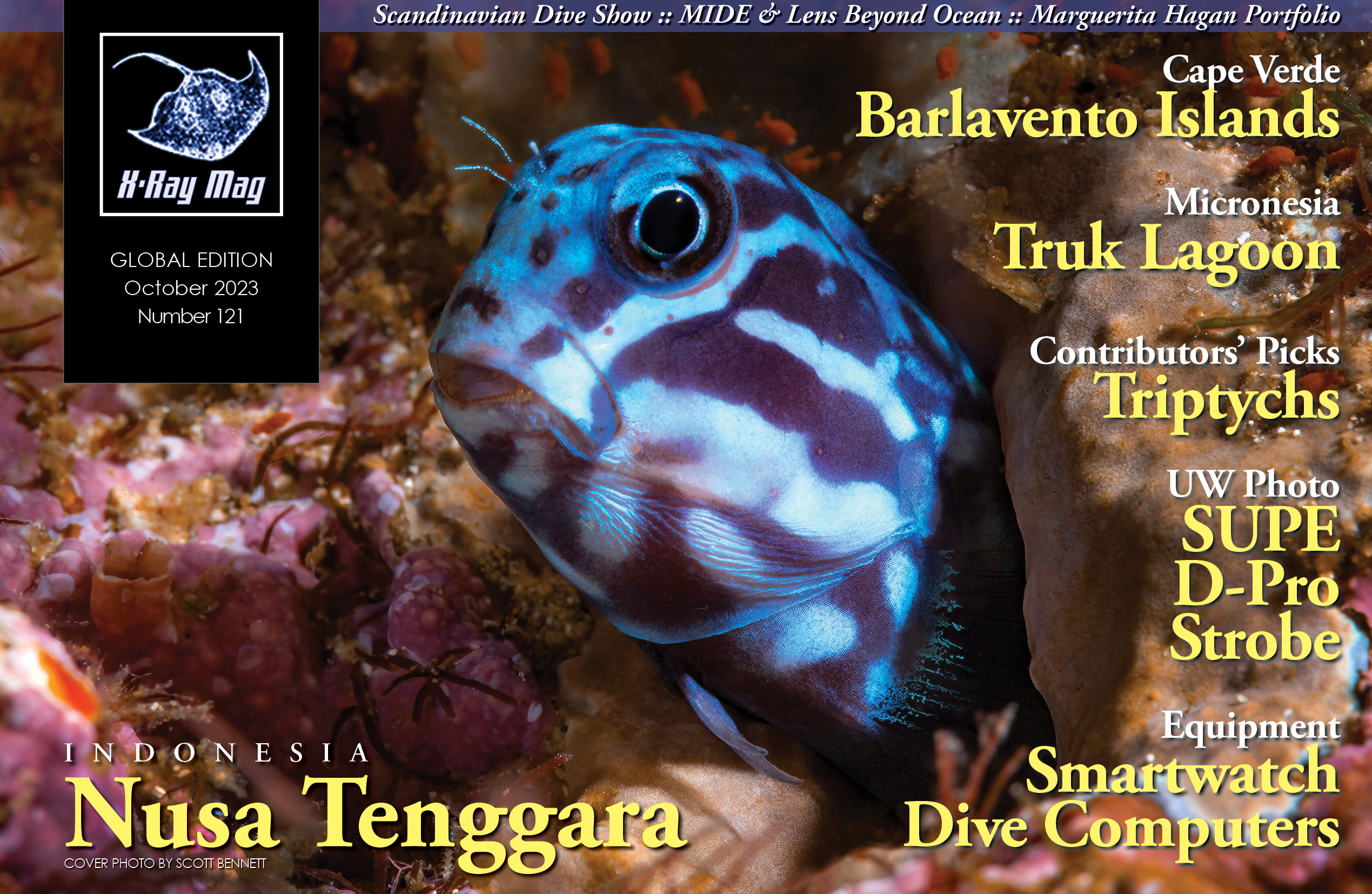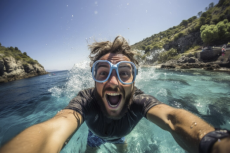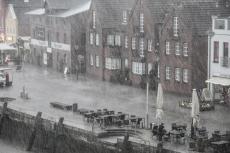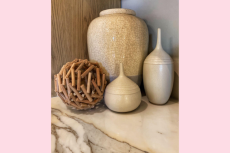Located in the eastern half of Indonesia is the island chain of Nusa Tenggara where unique marine life can be found on brilliantly colourful reefs as well as sites with volcanic sands, great for muck diving and macro photography. Scott Bennett takes us on a liveaboard adventure to three of the islands: Alor, Flores and Komodo.
Contributed by
When it comes to superlatives, diving and Indonesia certainly go hand in hand. Situated in East Nusa Tenggara in eastern Indonesia, the Alor Archipelago is certainly off the beaten track. While everyone knows the World Heritage site of Komodo, these islands to the east are decidedly more remote, offering unspoilt reefs teeming with abundant marine life. Eager to dive someplace new, a trip aboard the Gaia Love immediately caught my attention. With an itinerary that included Alor, Flores and Komodo, how could I refuse?
The only downside? The distance. Although easily accessible from Southeast Asia, reaching the embarkation point of Flores from my home base of Toronto required five separate flights. Not wishing to arrive shattered, I opted to leave 10 days early, making stops along the way. After three nights in Singapore (my favourite food city), I continued to Bali for a few days diving at Tulamben on the island’s eastern coast. I then arrived in Labuan Bajo on the island of Flores two days before the liveaboard departure. Experience has taught me that arriving the day of departure is never a good idea, as cancelled or delayed flights and lost luggage can spell disaster.
Flores is one of those places that most people have never even heard of, let alone find on a map. One of the Lesser Sunda Islands in eastern Indonesia, it would be easy to assume it to be somewhere in Portugal, as Flores translates as “flowers” in Portuguese. The Portuguese first arrived in 1511 and have had a strong influence on the region ever since. However, I had an additional reason for the early arrival; Labuan Bajo is the jumping-off point for tours to Komodo National Park.
Komodo
In the old days, mariner maps would label unexplored regions with “here be dragons,” but Komodo is home to the real deal! I had wanted to visit on previous trips to Bali, but things never worked out. With day tours available, I would finally get my chance.
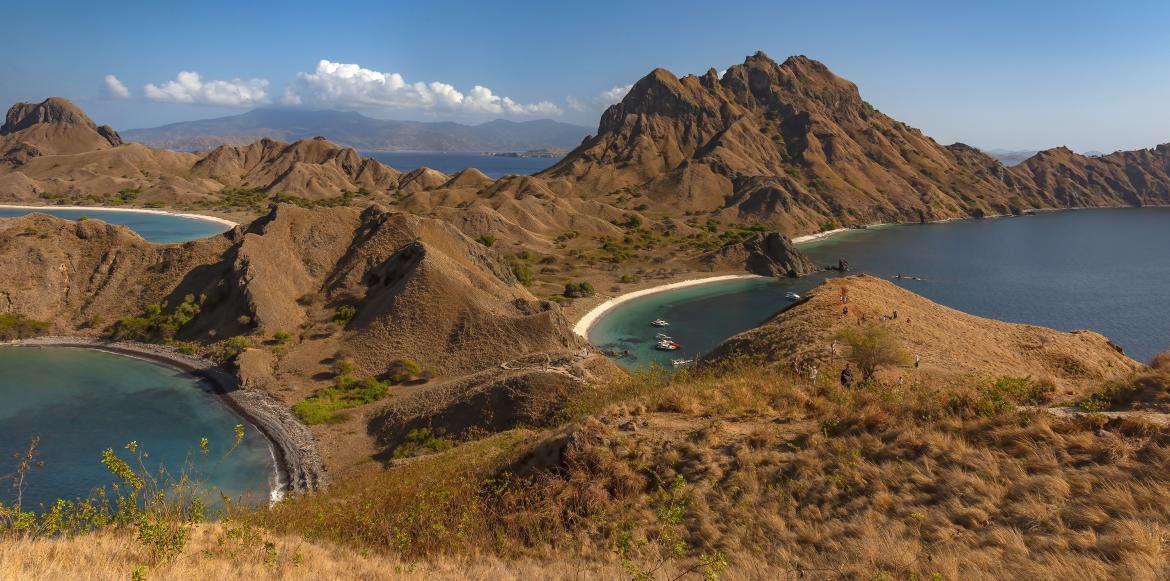
The day had an early start, with a 6:15 a.m. pickup. As it was peak tourist season, there were lots of people heading for the park, and the harbour was jam-packed with boats, the majority of which were liveaboards or day-trip vessels. Fortunately, I had opted for the speedboat option, which shortened travel time considerably. Nevertheless, it would be a long day of around 10 hours. With all 24 passengers aboard, we set out for the Komodo National Park by 7:00 a.m. and arrived at our first stop an hour later.
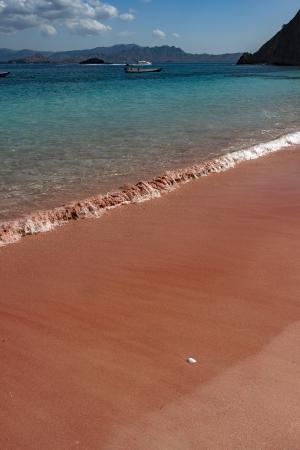
Padar Island. Padar Island features one of the most iconic views of the entire park. The island’s geography is quite striking, with a series of peninsulas jutting outwards like extended fingers into the turquoise waters. A steep trail leads to a spectacular lookout 185m and 800 steps above the island. With only a 90-minute stopover, I was uncertain I would make it, but decided to give it a shot.
The initial section was not too bad, with several viewpoints on the way up, each more spectacular than the last. The incline steepened with elevation, but I pushed on and finally made it to the top. Being the dry season, the landscape was a study in burnt sienna, especially dramatic in the morning light.
Descending proved easier on the lungs but harder on the knees. I suspected my leg muscles would protest the next day. (And they did!)
Pink Beach. Our next stop was Pink Beach, also located on Padar, a 15-min boat ride away. Nearly a dozen boats crowded the shoreline, as a multitude of snorkellers crowded the turquoise waters. Fringing the beach, a series of warungs (family-owned shops) sold snacks and cold drinks. The beach really was pink, and not just a little bit. It was truly striking! With a 10-day liveaboard trip ahead, I opted to pass on the snorkelling.
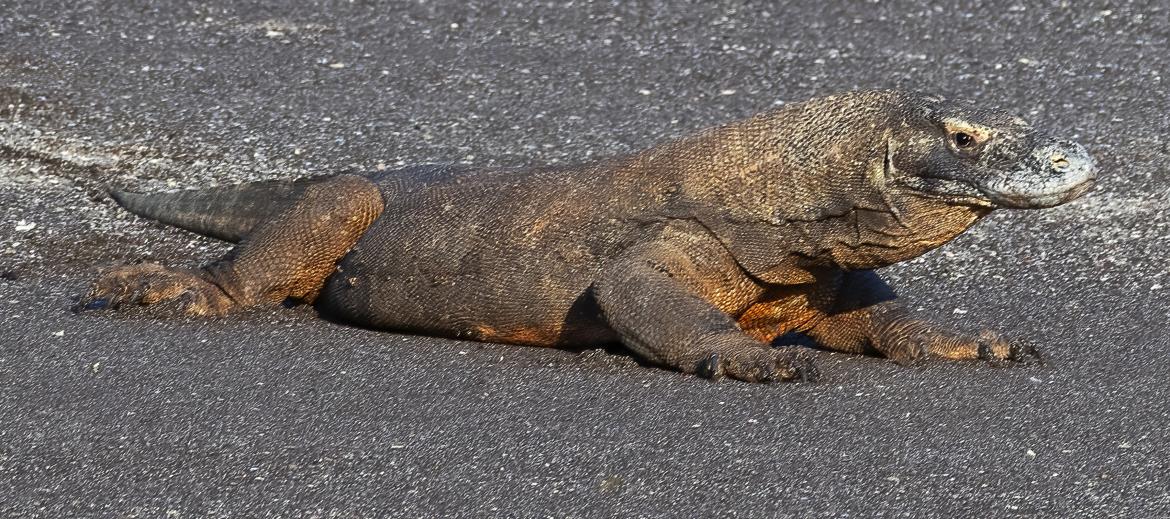
Komodo dragons
Found only on Komodo, Rinca and a few neighbouring islands, Komodo dragons are the world’s largest surviving lizard species. Measuring up to 3m in length, and armed with razor-sharp claws and teeth, they are the top predators of their island domain. Aided by venomous saliva, they can tackle deer and even water buffalo. Despite this, the park rangers’ sole line of defence is a large stick to push them away, an actuality that is both absurd and highly unnerving.
As is always the case with nature, seeing wildlife is never a guarantee; after all, it is a national park, not a zoo. In the end, we saw five dragons—a pretty good number. Groups visiting the previous day did not see any, causing some irate clients to demand a refund.
On to the liveaboard
Finally, it was departure day. On hand to pick me up was Deddy, Gaia’s senior divemaster. From Labuan Bajo’s harbour, it was a short skiff ride to the Gaia, which was anchored out in the bay. The entire staff was on hand to give me a warm welcome—actually, more of a rousing cheer! I then met Cruise Director Gerry, who gave me a tour of the boat. The main deck featured a spacious lounge and dining room, with a unique additional feature: The camera room lay adjacent to the lounge. Each camera station provided ample space and plugs, while being inside ensured no unwanted moisture issues due to humidity.
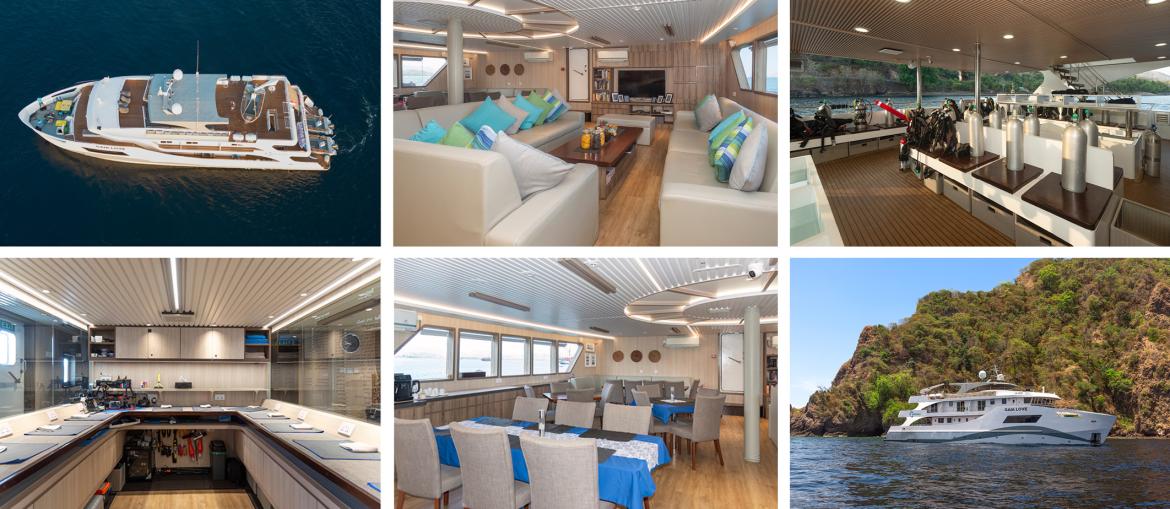
Most liveaboard accommodation can be on the compact side, where laying on the top bunk means that your face is inches below the ceiling. Not so on the Gaia. I had an actual room, with twin beds and ensuite bathroom with separate shower. Between the beds was a desk and chair, with a trio of chocolate bars sitting on it. Suddenly, it hit me… This was no ordinary liveaboard; it was a luxury hotel that just happened to be a liveaboard.
With the remainder of the day at leisure, I decided to assemble my camera gear. By the camera room were the photos and names of Gaia’s entire staff of 22—but when they were kids. Amusingly, they were all recognizable. By mid-afternoon, the remaining six guests were aboard. In the end, we had four Americans, two Belgians and one lone Canadian. Around 4:00 p.m., everyone assembled in the lounge, where we met Giel, Gerry’s partner and Gaia’s second cruise director. Over coffee and freshly baked cinnamon rolls, Giel gave us a briefing about the vessel and the ensuing nine days.
The Gaia does not have a set-in-stone itinerary, with each day’s sites to be dictated by local conditions, currents and other dive boats. We would start off in Komodo for the first three days, followed by a day in Flores and the remainder in Alor. With our route encompassing sites in both the Indian and Pacific Oceans, we would also experience some strong currents along with wild variances in water temperatures. Dive guides alternated between the boats daily, allowing everyone a chance to dive with all four: Deddy, Refly, Ando and Farly.
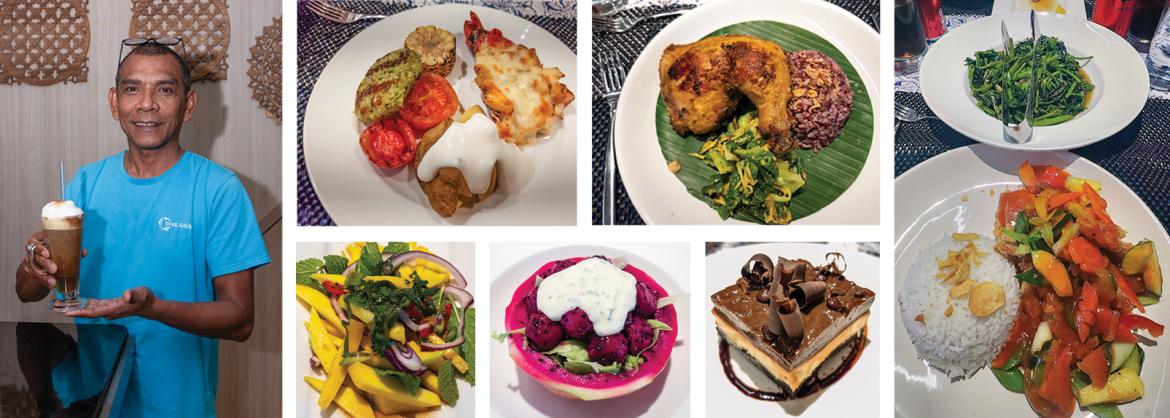
Culinary delights
With the diving portion finished, it was time for the important part—the food! Meals aboard the Gaia are plated, with a choice between meat and vegetarian options daily. As good as buffets are, they can become exhausting after a few days, let alone a week. Breakfast orders were taken after dinner while orders for lunch and dinner were taken by Giel after breakfast. We soon discovered that the meals were real gourmet fare, with exquisite presentation.
The vessel also has two coffee machines, one for regular coffee, cappuccino and latte, and the second was a special “bling-bling” machine (in Giel’s words)—the sole domain of barista extraordinaire, Andy. Every day, the period between 4:00 and 5:30, was specialty-coffee time, with a different creation daily. I promptly knew where I had to be at that time, the rest of the week! (Day One was affogato, a coffee-based dessert).
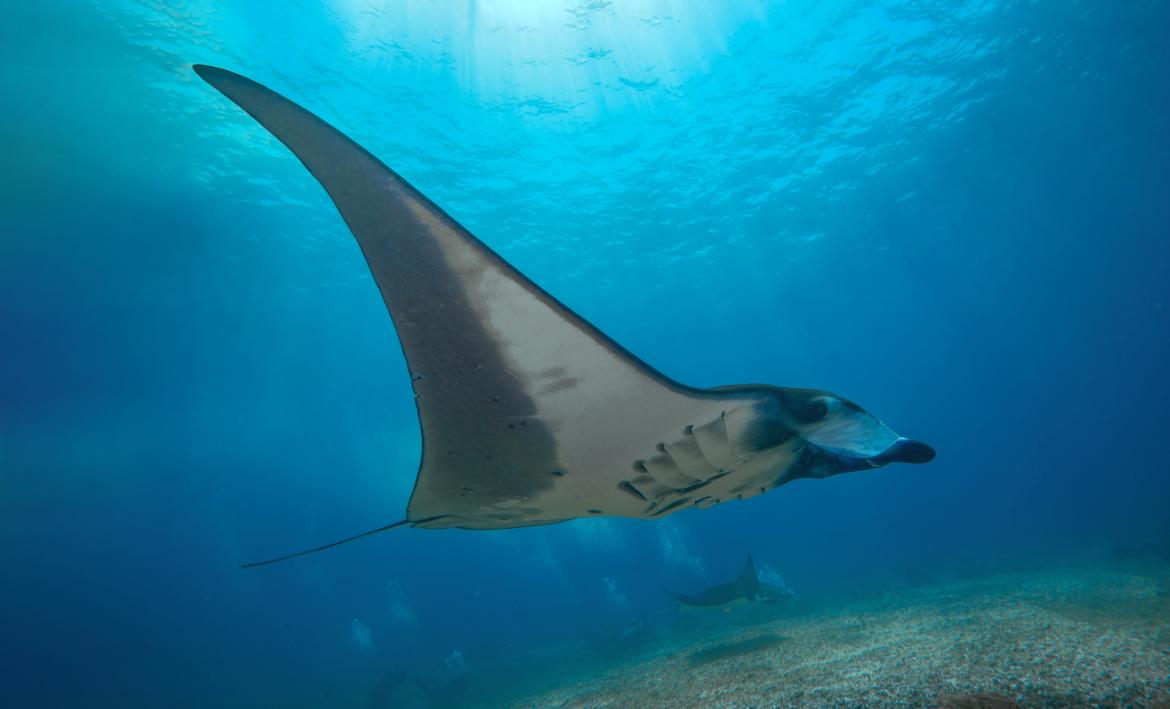
Diving Komodo
We then set out for Komodo, where we would spend our first night. En route, the rugged islands glowed orange in the waning daylight. By this time, the tourist boats were long gone, and the islands had reverted to their primordial atmosphere.
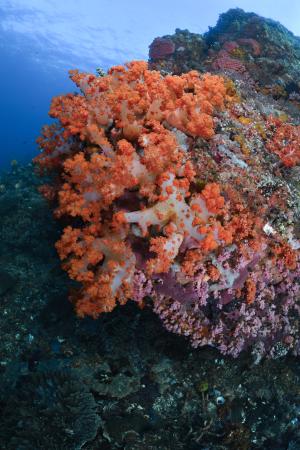
Manta Alley. The next morning, I was up at 6:00 a.m. and headed to the dining room for a pre-dive snack of yoghurt and coffee. Our first two dives would be at Manta Alley, one of Komodo’s signature sites. Beforehand, Gerry and the guides set out to check the conditions, especially with regard to currents. Upon returning, they had one word for us—mantas! It was also just 22°C—a temperature one does not normally associate with tropical waters. Nevertheless, I decided to brave a 3mm suit. Hey, I am Canadian, after all!
Talk about a good omen, when the first thing you see on a first dive is a manta, you just know the rest of the trip will be extraordinary! The visibility was not great, but that is exactly why the mantas were there, lured by the abundance of plankton in the water. Although I did not get close, there were plenty of them, and it was a joy just watching. Not to be outdone, the reef here was also impressive, with numerous rocky outcrops shrouded with fans and soft corals. Heading back to the Gaia, the dive crew was ready and waiting with a rousing greeting of “Yabba-dabba-do!”
The second dive was even better. Switching from my 15mm lens to a 16-35mm lens, I parked in front of a cleaning station, and was able to get closer shots of the mantas. As long as you stayed still and lower than them, they came quite close. I am still in awe at the grace and majesty of these creatures. If I had to name a favourite sea creature, the manta is it!
Cannibal Rock. After lunch, it was time to move on to our third dive site situated near Rinca Island. Another of Komodo’s iconic sites, Cannibal Rock is a small seamount situated in Loh Dasami Bay, between Rinca and Nusa Kode. Ascending from more than 40m to within a few metres of the surface, the site is home to an astonishing array of life, from vibrant soft corals and sponges to colourful invertebrates.
For photographers, it is a tough call—macro or wide angle? Ideally both! Alas, with only one dive, it was macro. There were nudibranchs galore along with legions of tiny yellow sea cucumbers, nudibranchs, zebra crabs, scorpionfish and feather duster worms in a dazzling array of colours. With so much to take in, it was difficult to know where to aim the camera.
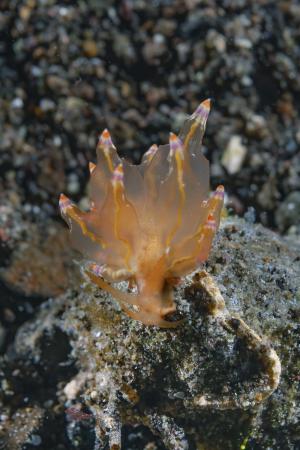
More dragons. Before the night dive, we had the option to go out for a cruise along the shoreline to look for dragons. In years past, the liveaboards would bait them with chicken meat, but since the Covid pandemic, the park authorities put a stop to these practices. At that time, the sound of a boat would lure them to the beach, en masse; but nowadays, sightings are not a guarantee. Still, we saw a few, with one coming down to lay right on the beach. Despite their presence, plenty of wildlife was about, including monkeys, wild pigs, sea eagles and reef herons.
Torpedo Alley. The night dive at Torpedo Alley would be a bonfire dive, where lights would be set up in advance prior to our entry to attract weird critters from the deep. Awkwardly, I back-rolled in, minus a weight belt, and had to wait for the other skiff to bring one over (something I would not repeat again). By the time I reached the bottom, the only thing the lights attracted were huge numbers of tiny shrimp. Like clouds of undersea gnats, they promptly engulfed my strobes’ spotting lights, making photography a challenge. Moving on, we found plenty of subjects, including painted frogfish, various nudibranchs, mantis shrimp, tiny crabs on sea pens and cuttlefish.
Gili Lawa Laut. After dinner (seriously, Beef Wellington?!), we weighed anchor and set out for Gili Lawa Laut, a small island situated off the northern coast of Komodo. The first dive would be at the ominously named Shotgun, a channel between two bays. Giel recommended leaving cameras behind, so I decided to pass. Instead, I had an early breakfast, this time indulging in nasi goreng, fried rice with vegetables and an egg. Thanks, Andy!
Current City. We then moved on to an area of Komodo called Current City. Here, warmer water from the Pacific surges between the islands to collide with cold upwellings from the Indian Ocean, creating powerful currents, eddies and whirlpools that were a sight to behold! In places, it resembled the rapids of a fast-moving river in the ocean. I knew Komodo currents were legendary, but I had never seen anything like this!
We spent the next two days here diving four different sites. Currents were strong but tolerable, but the rewards were vibrant reefs and 30m visibility. Currents bring in the fish and there were plenty of them, including yellow-ribbon and giant sweetlips, black-spotted porcupinefish, surgeonfish and dense schools of anthias.
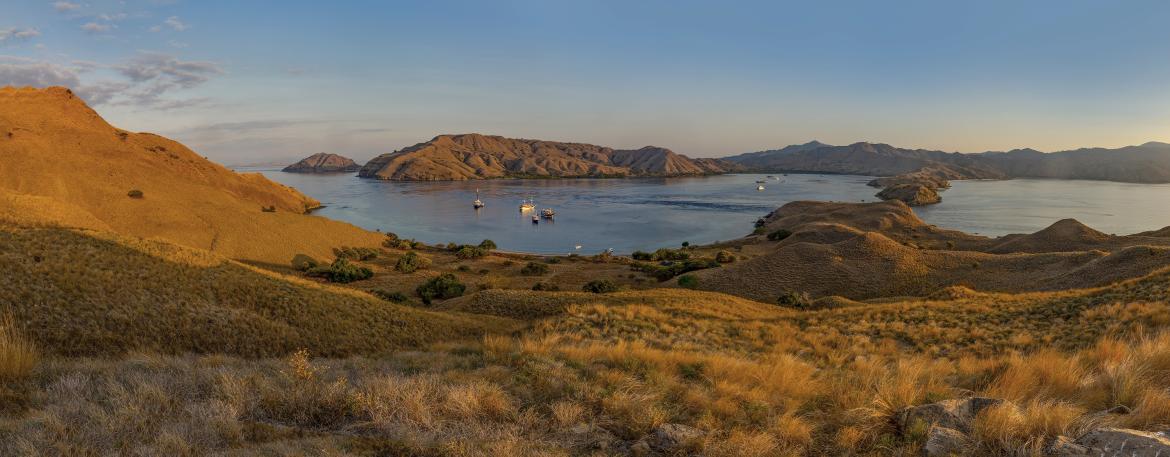
Gili Lawa Darat. After the third dive, two of us accompanied Giel to the island of Gili Lawa Darat for a sunset hike. We did not go all the way up, but even from the lower viewpoint, the view facing Komodo Island was spectacular! We finished with a night dive right near the island’s jetty. The highlight was shooting a portrait of a slumbering flying gurnard, a fish I have never been able to photograph up close.
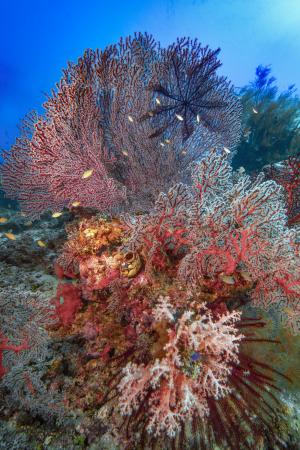
Batu Bolong. The next day started off with a real adrenaline rush at Batu Bolong. Essentially an isolated rock in a raging torrent, we would dive the protected leeward side where the water was calm. However, severe downcurrents were possible in conjunction with powerful currents at the corners.
As a result, the dive briefing was more detailed than usual. Safety was paramount; it was imperative to always stay near the guides. People have died here, and we did not want to contribute to the statistics.
Plunging in, the water was calm, but the marine life was astounding! Reef fish pulsed along the wall, while out in the blue, whitetip sharks and giant trevally patrolled in search of food. A few Napoleon wrasse kept their distance, almost tempting us to chase them.
We descended to 30m, where an overhang sheltered several soldierfish and striped sweetlips. We then commenced on a slow zig-zag ascent up the slope, ensuring to keep well clear of the treacherous currents at the edges. There was so much going on, I could have easily spent an hour watching the show. During my safety stop, a diver from another boat crashed right into me, and Gerry had to literally pull the diver off. Fortunately, I was spared the downcurrents and finished the dive unscathed and exhilarated.
Takat Makassar. Our next dive could not have been more different. A barren expanse of broken coral punctuated with the odd coral bommie, Takat Makassar will not win any awards in the beauty department. Looks are deceiving, however, as it turned out to be a manta highway with plenty of traffic! Drifting with the current, we saw many, either hovering in the current or zooming past us.
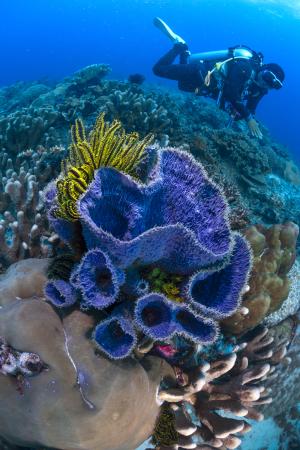
However, it was the final encounter that would be the best. A pair were hanging in the current a short distance away, and our entire group decided to wait. Despite the current, I was able to position myself beside a large coral bommie. To my amazement, they slowly drifted in my direction until they were right beside me. It turned out the bommie was a cleaning station, and they had arrived for servicing. I dared not move, as I did not want to alarm them. A truly exhilarating moment!
On to Flores
After a third dive nearer to mainland, we bid Komodo adieu and commenced our overnight voyage to the northern coast of Flores. Unfortunately, strong unseasonal winds hampered our progress, so the dive schedule was adjusted accordingly, with three dives instead of the planned four.
Pemanah Kecil and Serbete. Featuring a massive wall and amazing visibility, Pemanah Kecil offered an impressive start to the day. It was one of the prettiest reefs of the trip, with huge orange and lavender fan corals draped with feather stars and 30m visibility. Farther south, we visited Serbete for a late afternoon dive, arriving just as blacktip and whitetip reef sharks had just come out to hunt.
Tanjung Wotang. Dinner was at 6:00 p.m. followed by a night dive at Tanjung Wotang at 7:30 p.m. All day long, Gerry had regaled us with accolades for this site, so I could not wait! While gearing up, I remarked that I would love to photograph a bobtail squid, having seen only one in 30 years of diving.
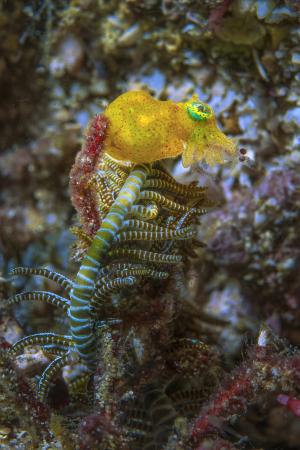
The water was a cool 22°C, but from the first critter, the cold was quickly forgotten. Just beneath the surface, a small reef squid was attracted by my torch beam and held still just long enough for me to capture a few images of it. Minutes later, Refly pointed out a dark blotch on the sand. Upon closer inspection, my jaw dropped—it was a bobtail squid! In my torchlight, it was positively radiant, glowing like tiled blue porcelain. We found two more, each obligingly posing for photos.
My good fortune did not end there. Whenever Refly pointed out something, I quickly learnt to take a picture, regardless of whether I saw anything or not. That instinct paid off, big time. In one shot, I captured a miniscule yellow squid eating a shrimp!
The photo ops were relentless; it seemed there was a new critter in every square metre. While photographing a scorpionfish, Refly frantically tried to get my attention. I continued with the scorpionfish, but he was
really insistent, and I soon found out why. Finning over, I discovered a jawfish with a mouth full of eggs. In all my years of diving, it was a subject I had long dreamt of photographing. Inching closer, I was astonished to see the eyes of the babies clearly visible!
Along with an assortment of nudibranchs, a striking blenny caught my attention. Its head boldly patterned blue and black, it turned out to be a Namiye’s combtooth blenny, a species I had never seen, let alone heard of. Amazingly, all the subjects I photographed were very tolerant. I guess they have not been overwhelmed by the macro paparazzi found at popular muck sites elsewhere.
Back aboard the skiff, I started shivering, but a hot shower was only minutes away. No sooner had I ascended the stairs, a warm towel was draped over my shoulders while a steaming mug of hot chocolate was waiting at my station. It simply does not get any better than this!
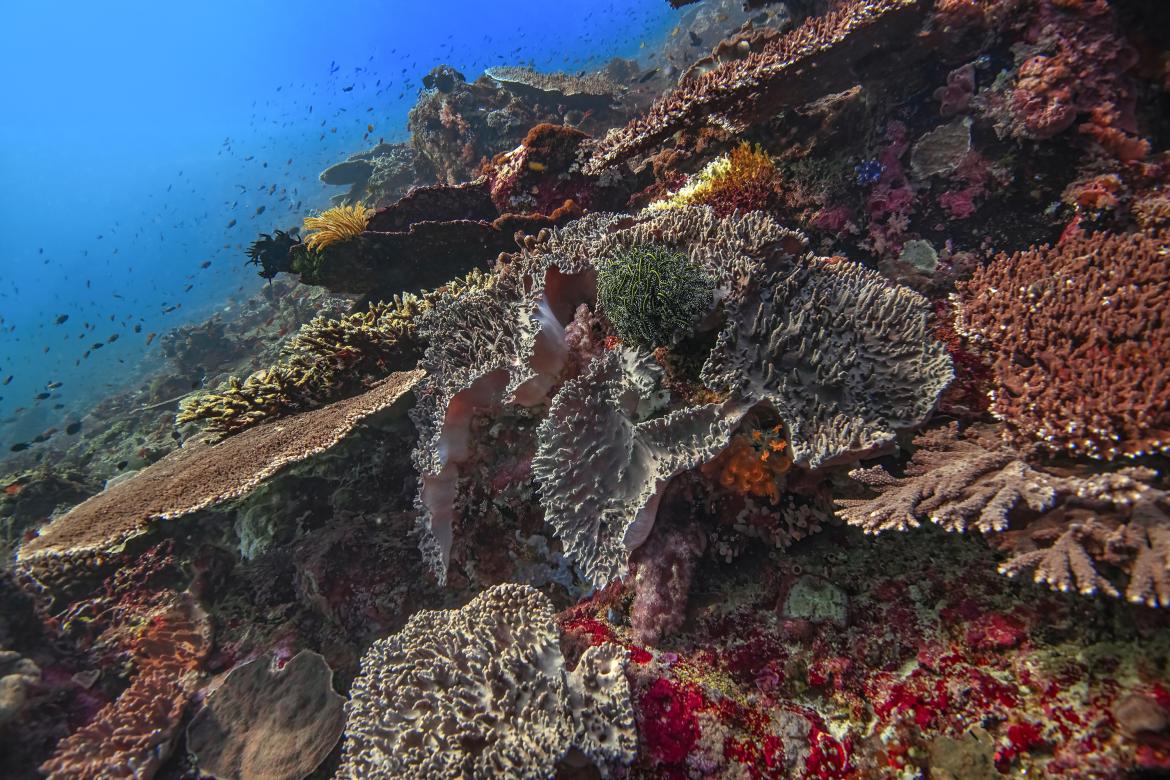
Alor
Watu Balu. After another overnight journey, we finally arrived in Alor. Our first dive was at Watu Balu, off the island of Pantar. Like Komodo’s Current City, conditions were challenging, with Pacific currents going out and the cold Indian Ocean currents coming in. We would dive the island’s leeward side, so there would not be any issues. Well, there was one, and it was a doozy: the temperature. If anyone was not fully awake before the dive, that would change quickly. In the shallows, it was a chilly 20°C. Despite this, the reef was vibrant, with beautiful sponges, and leather and hard corals in the shallows at 3m.
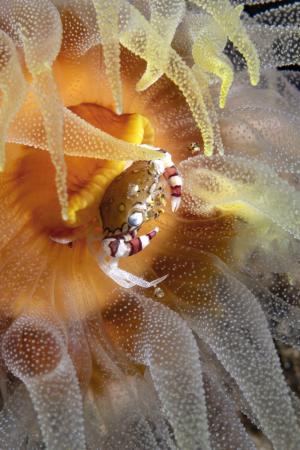
Descending to 20m, things got really interesting. I hit a thermocline and the temperature plummeted to 17°C! It was barely tolerable in my 3mm suit, and one of the Americans did not fare so well. He indicated “dive over” and headed back to the surface. Fortunately, the thermocline was temporary, and temperatures returned to the relative warmth of 20°C.
Forgetting the cold, I enjoyed the rest of the dive. Schools of anthias and blue and gold fusiliers swarmed in abundance, while on a ledge beneath an overhang, Geddy found a resting wobbegong shark. Back on the Gaia, Gerry said she spotted a mola mola (sunfish) at 35m but did not go after it. I cannot say I blame her, with those temperatures.
At breakfast, Andy served me a steaming bowl of bubur ayam, an Indonesian porridge with chicken—just the ticket for warding off the dive’s chill. A second cup of coffee did not hurt either.
Beangabang. After a second dive off Pantar, we headed for our final stop at Beangabang, regarded as one of Alor’s premier muck sites. We would do two dives here, one in the afternoon, followed by a night dive. Switching my camera setup to macro, I could not wait to get in the water!
The local kids came out to greet us in their boats as we geared up for the first dive. Although it was relatively shallow, there was plenty to see. Seahorses, juvenile boxfish, giant mantis shrimp, sea hares, stick pipefish and squat shrimp all competed for my camera’s attention.
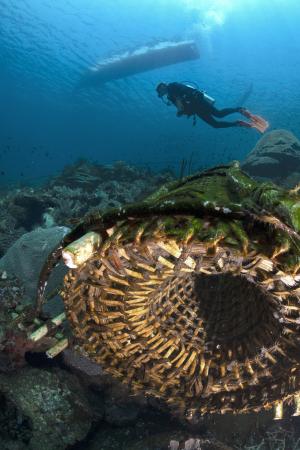
Towards the end, Refly was excited by something and motioned me over. At that moment, a wonderpus octopus erupted from the sand! Boasting dramatic white stripes on a coppery-hued body, it drifted, tentacles fluttering gently before settling back on the sand. The only downside was that I had the 105mm lens on my camera, which could not encapsulate the depth of field to keep the entire creature sharp—a minor inconvenience, as it is a privilege just seeing one.
The night dive proved even better than the first, featuring a different cast of intriguing characters: stonefish, juvenile clown frogfish and a variety of nudibranchs, including pleurobranchs, flabellinas and elysias. Refly proved to be the “nudibranch whisperer,” as he had a real knack for finding them. The dive was capped off with another bobtail squid, this one resting on a bed of red algae.
We spent the next three days exploring a variety of sites around Alor and the surrounding islands of Pantar, Pura and Reta, and the highlights were many.
Tanjung Muna. A morning dive at Tanjung Muna, off Pantar, featured a spectacular wall with large sea fans, black corals and barrel sponges, patrolled by golden sergeants, pyramid butterflyfish, sergeant majors and a massive school of black snappers. One in our group even spotted a few hammerhead sharks cruising below 30m. In the shallows, a school of pinnate batfish allowed a close approach, while a pair of spotted eagle rays and a giant barracuda were not as obliging.
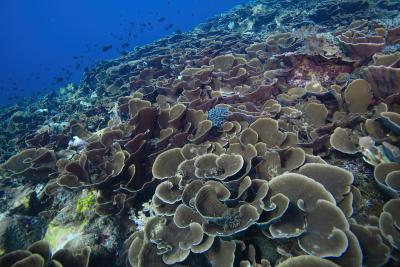
Geraja Tua. At Geraja Tua, the local village’s fishing nets provided interesting photo subjects, with superlative visibility revealing the boats on the surface above. Yellow-ribbon sweetlips darted amongst the bommies, as bluefin trevally patrolled in search of a meal. By this point, 22°C temperatures did not bother me in the slightest. During the checkout before our dive, Gerry spotted the fin of a mola mola breaking the surface, but we did not get to see it.
Kampung Yan & School’s Out. Off Pura Island, Kampung Yan and School’s Out were home to impressive expanses of hard coral gardens, including some truly immense table corals. It was especially hearting to see such thriving reefs with virtually no effects of coral bleaching. Then again, warm water is not exactly an issue here!
Crucifixion Point. Crucifixion Point, named for the trio of crosses commemorating a small passenger ferry that capsized here, was another beautiful site, with abundant fans, tubastrea, soft corals and barrel sponges. Orange cup corals were especially prolific, their outstretched tentacles feeding in the current.
Intervals
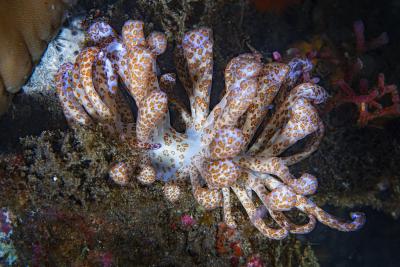
Between dives, there was still plenty of time for relaxation. I frequented the comfortable couch in the lounge, which was conveniently located beside a big jar of Oreo cookies. There was also a masseur on board, and his services were in especially high demand in the afternoons.
All through the week, the meals continued to impress. Dishes ranged from Asian specialties such as grilled turmeric chicken, papaya salad with prawns, and soto ayam (Indonesian chicken soup) to rib-eye steak, red snapper and even lobster thermidor! And then there were the desserts…
Muck diving
As good as the reef diving was, for me, the night dives were the real stars of the show. Indonesia is famous for muck diving, and Alor is as good as I have ever seen. For three nights, we anchored along the northern coast of Kalabahi Bay, which is home to several outstanding sites. Best of all, we had them all to ourselves!
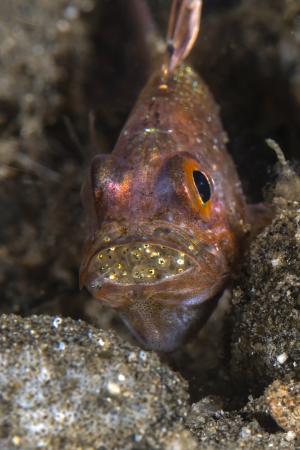
Mucky Mosque takes the prize for the trip’s most unusual site name. No, we were not diving a mosque, but a black sandy slope offshore from one. Alor's muck sites are home to some of the weirdest nudibranchs I have ever seen, and here, they were out in full force! Boasting stalk-like appendages, a Pustulose marionia was a new species for my list, along with some crazy phyllodesmiums. There is one red species I photographed I have yet to identify. Other notables included a pair of leaf scorpionfish, a large reef octopus, banded pipefish, harlequin and decorator crabs, and a feeding melibe nudibranch. With photo subjects everywhere, the hour just flew by. I did not want it to end.
Geraja Ampera. Our final muck dive at Geraja Ampera certainly went out with a bang! Several long-cirri phyllodesmium (solar nudibranchs) appeared along with Spanish dancers, reef squid, dwarf cuttlefish, a vivid red dwarf scorpionfish, and a few more indescribable nudibranchs. Ascending the slope, long-spined urchins were everywhere, and I am still amazed I did not impale myself. However, there was one final surprise: a cardinalfish brooding a clutch of eggs in its mouth, with one of the babies clearly visible, making an exit. Wow!
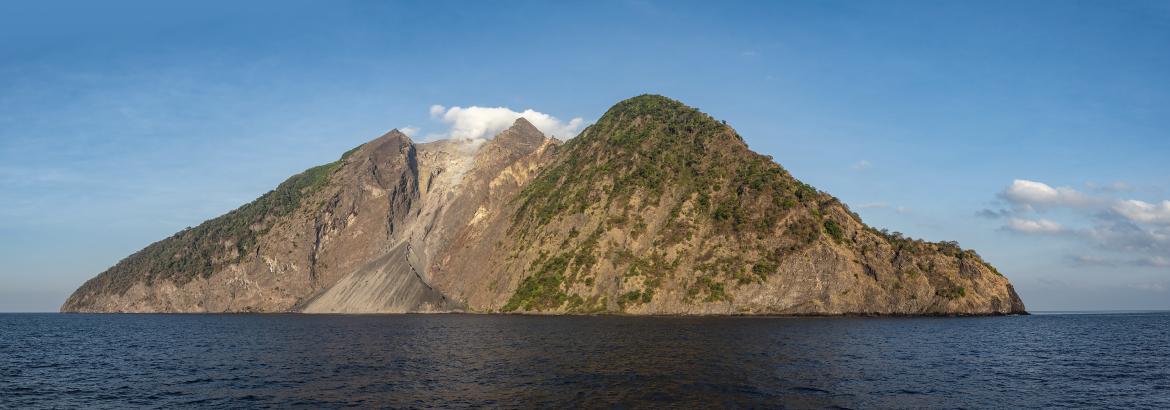
Komba
Sadly, it was time to bid Alor farewell and after dinner, we set out on the overnight trip to our final destination. Arguably, Giel and Gerry had saved the most spectacular location for last. Our final two dives would be off the island of Komba, situated some 70km northeast of Lembata Island, in the Flores Sea. This was no ordinary island, being home to the imposing silhouette of Mount Batutara, an active volcano. Until fairly recently, eruptions would occur every 20 minutes, but now it slumbered, a steady plume of steam indicating that its current state was only temporary.
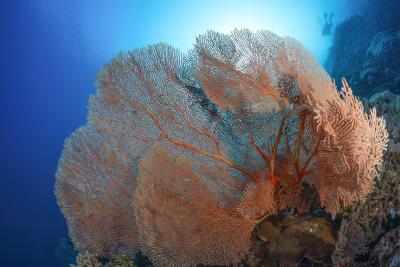
Volcano Drop. Our first dive site was the aptly named Volcano Drop. The scale of this location was truly epic. From below the surface, dramatic walls plunged precipitously to the depths. One would not expect vibrant coral gardens alongside an active volcano, but here they were. Massive gorgonians crowded the walls, interspersed with delicate lace, organ pipe and plate corals.
However, frequent signs indicated things were not all benign. Immense flows of black sand cascaded downwards, an indication that Mount Batutara was still very much alive. According to Giel, during its more active phase, you could hear the booms from the eruptions underwater, startling the schools of fish (and probably a few divers). In the shallows, it was fascinating to see corals growing right out of the black sand, something I have never seen before.
Komba Southwest. Our second and final dive at Komba Southwest proved equally dramatic. However, Komba offered something else we had not experienced on the entire trip—the water temperature was a balmy 28°C. That is an 11-degree temperature difference between the warmest and coldest sites.
On to Maumere
With our final dive concluded, it was time for the long journey back to Maumere. We would arrive in port late that evening, where we would spend the night before disembarking the following morning. At least there was no rush to disassemble my camera gear and pack.
However, Gaia had one final surprise in store. For our final dinner, we would be having a full-blown Rijsttafel, a Dutch word meaning “rice table.” In short, it was an Indonesian buffet of rice surrounded by dishes of meat and vegetables in mouth-watering sauces. The amount of food was both delicious and overwhelming; we could barely put a dent in it! Afterwards, the entire crew gathered to serenade us with music. It really felt like we were one big family, which would making leaving that much sadder.
I awoke to an empty boat, as all the other guests had departed for the airport. After breakfast and one final coffee from Andy, I bid farewell to Gaia and her crew and was transferred to the jetty. However, my adventure was not quite over.
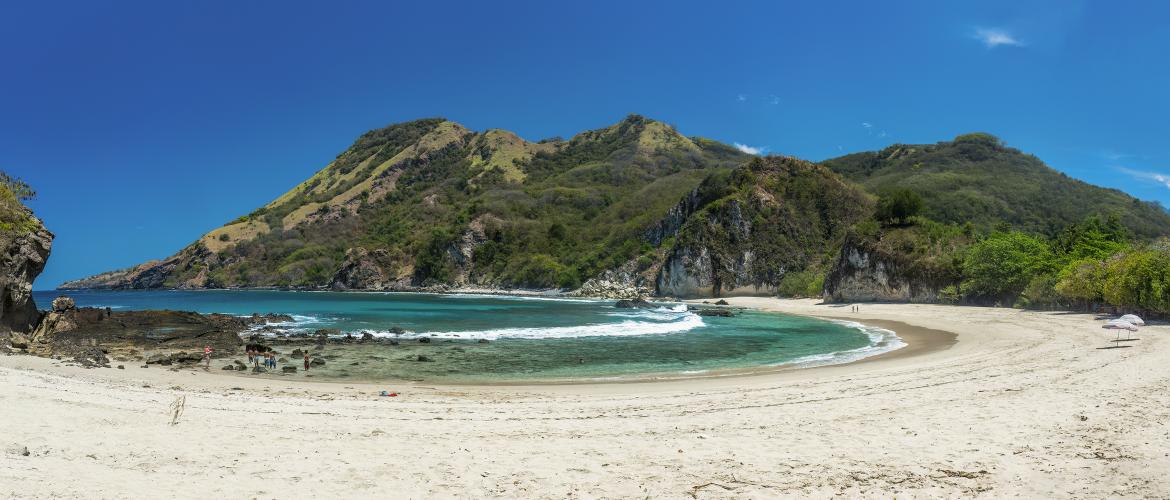
Kelimutu
Years earlier, I read about a volcano called Kelimutu and its trio of multicoloured crater lakes located on the island of Flores. I mentally filed it away as a place I would like to see but did not really expect to. After all, when would I ever get there? While planning my trip, I remembered Kelimutu and was curious to see where it was on the island. When I realized Maumere was only a few hours away by road, I decided to visit after the liveaboard trip. For the land tour operator, Gaia’s marketing manager, Cassandra Dragon, recommended Safari Tours & Travel in Manado, which arranged a two-day, one-night trip. I was set!
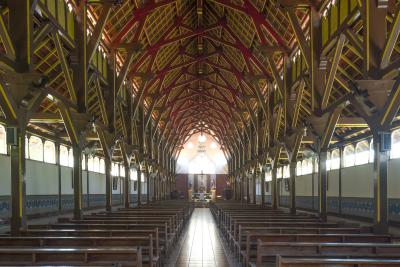
At the jetty, I met guide Ben and driver Tanto for my land excursion from Maumere to the city of Ende on the southern coast. Maumere is the largest city in Flores, but you would not know it on a Sunday morning. As the Flores population is 80 percent Catholic, the streets were virtually empty. Little did I know, this would be the last stretch of straight road we would encounter for nearly two full days.
Our drive to the Kelimutu Ecolodge would take around four hours. The island was really beautiful, with rugged, forested mountains interspersed with rice fields and charming villages. Physical distance has no bearing on driving time due to the steep grades and serpentine roads.
En route, we made a number of stops, including at a century-old church in Sikka and the beautiful white beach at Koka on the southern coast. By mid-afternoon, we arrived at the lodge, situated near the Kelimutu National Park. Nestled amongst rice fields framed by mountains, the location was idyllic and a great place to chill—a good thing, as the next day was going to be intense!
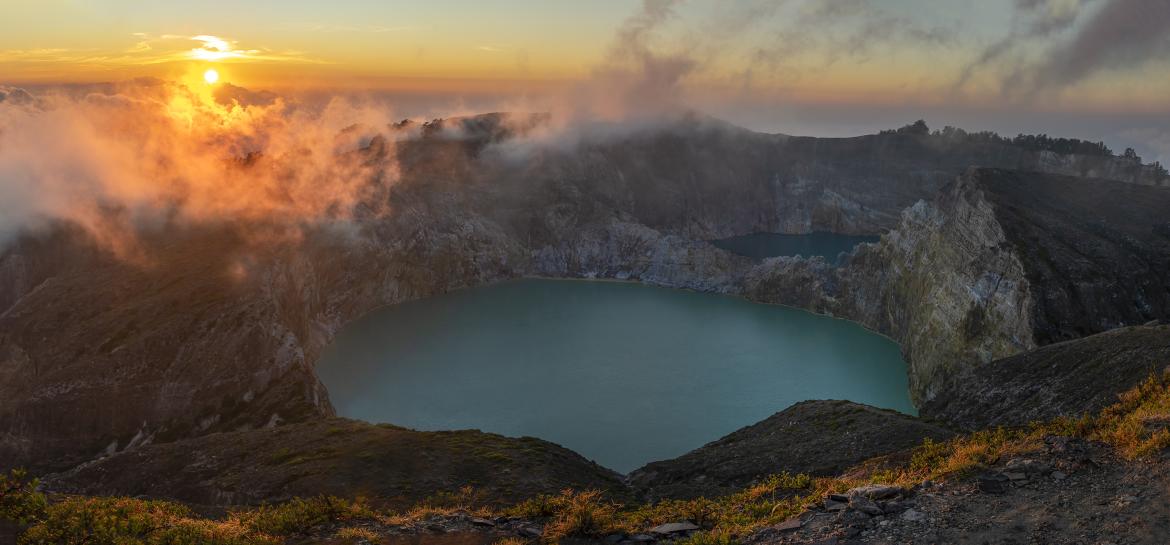
Hiking
The crater lakes of Kelimutu must be one of the most spectacular sights in all of Indonesia. Amazingly, each is a different colour, ranging from blue, green, pink or even brown and can change colour up to six times annually. Scientists still are not certain why the lakes change colour, but it is believed to be due to underlying gases and chemical elements.
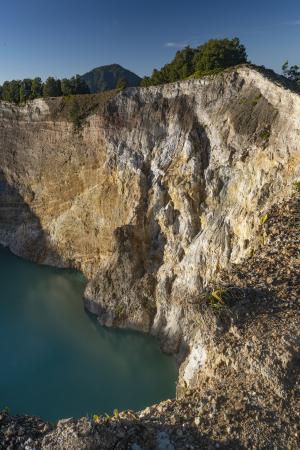
However, getting there for sunrise required some effort. For starters, there is a 3:30 a.m. wakeup call for a 4:00 a.m. departure. Then, there is a 30-minute drive to the national park, followed by a 20-minute walk to the viewpoint. Ben said the hike would be a few hundred steps, but it would not be steep like the ascent on Padar Island. I brought a headlamp, but trudging up steps in pitch blackness, with occasional swathes of fog wafting across was still unnerving. “Almost there,” said Ben, and before long, we came to the top, where a few people had arrived before us.
Just after 5:00 a.m., I could just start discerning details. Below, two of the crater lakes were just becoming visible, separated by a narrow rocky isthmus. Despite this, they were totally different colours. As we were over 1,600m, I wore my fleece jacket, but the temperature was not especially cold, even in the predawn hours. However, it was very windy. I really wished there had been someone there selling coffee!
With clouds still passing over, I was concerned we would not get our sunrise. While fussing about with my gear, I glanced up to discover the fog illuminated by golden light. The view was one that leaves travel writers grappling for adjectives. Sorry, I must go for the cliché: It was jaw-dropping! Encircled by fog and bathed with golden light, it was one of the most spectacular scenes I have ever encountered. The early start and uphill slog instantly forgotten, I savoured the moment, even putting down the camera to breathe it all in.
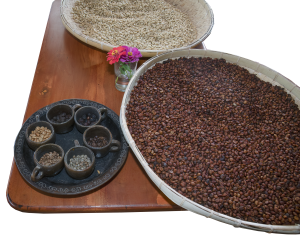
On the opposite side of the viewing area was the third and smallest of the lakes. Almost something of a geological afterthought, it was a darker blue, contrasting sharply with the turquoise tones of the other two. After photographing to my heart’s content, we started heading back down. En route, we stopped at another viewpoint looking over the farthest lake. From there, I could see just how high we had ascended. Kelimutu is one of those places that really must be seen in person and is a must if you are visiting Flores.
Back at the Ecolodge for breakfast, Ben noticed that I liked coffee. “Would you like to visit a coffee plantation today?” he queried. I could not say yes fast enough! After a rest, we checked out by late morning and started to make our way to Ende. We made numerous stops, including at a beautiful waterfall and a local market to buy some fruit. The passionfruit was easily the most delicious I have ever eaten!
Wolopaku coffee plantation. We had planned on stopping at a traditional village called Wologai, but it was closed to visitors due to a traditional ceremony. Instead, we headed to the Wolopaku coffee plantation. Here, I met owners Jakob and his partner Susan, who gave me a tour. At the end was the best part: sampling! I had no idea Flores grew coffee, and it was superb. I ended up buying a bag to take home.
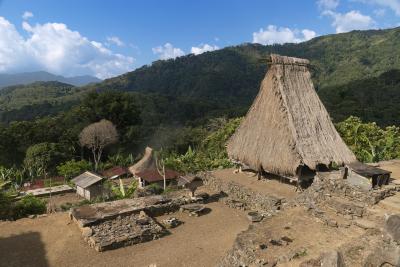
Saga. Before arriving at Ende, we stopped at another traditional village called Saga. Constructed on multiple levels on a steep hillside (great… more steps), the village is home to the Lio people and features traditional wooden houses with towering, thatched roofs. This was no tourist attraction, but the real thing. The steps were well worth the effort.
Afterthoughts
After nearly two action-packed weeks, my adventure had finally come to a close. Between the fantastic diving and the beauty of Komodo and Flores, I was overwhelmed. There was a lot to process, both mentally and photographically. This really was a special part of Indonesia and one not to be missed. Getting there may not have been easy, but the rewards were many. ■
Special thanks and appreciation go to the owners and staff of the Gaia Love liveaboard (divegaia.com) for their generous hospitality, outstanding service and superb assistance.

